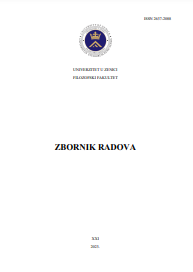PROŠIRENI GLAGOLSKI ADVERBIJALI UZROČNOGA ZNAČENJA KOJI SE U TURSKOME JEZIKU DERIVIRAJU DODAVANJEM ABLATIVNOGA SUFIKSA NA IMENSKE SKUPINE KOJE NASTAJU PREOBLIKOM GLAGOLSKIH ISHODIŠNIH REČENICA
EXTENDED CAUSATIVE VERBAL ADVERBIALS IN TURKISH LANGAUGE DERIVED BY ADDING ABLATIVE CASE SUFFIX TO NOUN PHRASES FORMED BY TRANSFORMING INITIAL VERBAL CLAUSES
Author(s): Edina Solak, Mirza Bašić, Amina HadžimejlićSubject(s): Language studies, Theoretical Linguistics, Turkic languages, Phraseology
Published by: Filozofski fakultet, Univerzitet u Zenici
Keywords: Turkish language; extended verbal adverbials; causation; ablative case suffix; noun phrases;
Summary/Abstract: In Turkish language, extended causative verbal adverbials can be expressed by different syntactic constructions. One of those syntactic constructions consists of the ablative case suffix and the lexical core, i.e., a noun complement receiving the ablative case suffix. In such causative adverbial phrase, the lexical core is a noun phrase which is formed during the process of nominalization by transforming the initial clauses, where the function of the correlative is marked by verbal nouns ending in -DIk / -(y)AcAk. The primary objective of this paper is to analyze grammatical and semantic characteristics of extended causative verbal adverbials derived by adding the ablative case suffix to noun phrases that are formed during the process of nominalization by transforming the initial verbal clauses. The analysis is based on concrete (con)textual examples from the following novels by Kemal Tahir: Esir Şehrin İnsanları, Esir Şehrin Mahpusu i Yol Ayrımı. The paper discusses semantically similar constructions in Bosnian language and, in this way, it attempts at indicating differences and similarities between syntactic constructions expressing causation in Turkish and Bosnian language. All terms mentioned in the paper, which carry gender significance and gender characteristics, encompass in the same way both masculine and feminine gender regardless of whether they are stated in the feminine or masculine gender. The authors of this paper are the authors of all the translations mentioned in the analysis of the examples.
Journal: Zbornik radova Filozofskog fakulteta
- Issue Year: 2023
- Issue No: XXI
- Page Range: 170-195
- Page Count: 26
- Language: Bosnian

